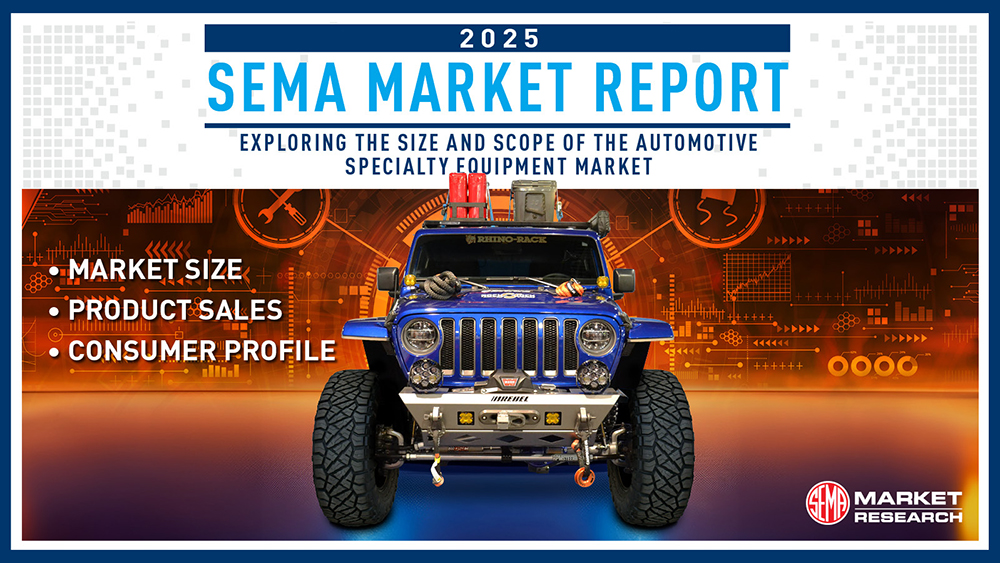The Specialty Equipment Market Association (SEMA) has released its 2025 Market Report. The study uncovers new consumer trends impacting the automotive aftermarket industry and the wider automotive sector, with implications for businesses and automotive enthusiasts. With U.S. consumers spending approximately $52.65 billion accessorizing and modifying their vehicles in 2024, there is a real appetite to better understand who is driving these sales and where growth opportunities exist, stated SEMA officials in a press release.
Highlights From the 2025 SEMA Market Report
The report breaks down trends by vehicle type and category of parts and accessories. Here are some highlights from the research as provided by SEMA.
- Based on its research, SEMA anticipates continued growth through this year, albeit slower than the COVID-period boom when enthusiasts used their free time to work on their vehicles. The following several years should see a gradual return toward a more normal, long-term trend of 4% to 5% annual sales growth.
- Our nation’s fleet is growing, a product of high new-car sales and consumers keeping their vehicles for longer periods. The average age of vehicles in the U.S. continues to climb, reaching a record high of eight years in 2025, according to S&P Global Mobility. As the average sales price of vehicles continues to rise, more owners will likely seek out repairs, upgrades and modifications that extend their vehicles’ lifespans.
- Most product categories showed steady or slightly rising sales numbers in 2024, and SEMA projects this growth to continue through 2025. Suspension, exhaust, and engine control products were subject to slightly higher sales growth than the market at a bit over 2%, a continued trend as they’ve maintained similar growth since 2021.
- After seeing a pandemic resurgence, mobile electronics sales in 2024 experienced some decline in 2024, mainly with GPS navigation and sound systems. Sales within this category have stalled somewhat in recent years as new vehicles have included more high-end electronics and become more technologically advanced.
- Pickup trucks dominate the market, while crossover utility vehicles (CUVs) are the fastest-growing vehicle segment on the road.
- Conversely, there is a continued drop in production and sales for traditional cars (coupes and sedans), while some sports cars are also seeing production cuts.
- The specialty-equipment industry moved early in online sales to meet the demand for specialty parts that were not being sold in typical retail locations, and it has impacted consumer habits. Consumers now split their spending equally between offline and online channels and have fully adopted mixed-mode shopping, sometimes purchasing online and picking up at a local brick-and-mortar location.
Pickups in the Driver’s Seat
Pickup trucks account for a third of the overall specialty-equipment market, continuing a several-year run with the most spending on accessories compared to other vehicle segments, notes the report. Because sales of new pickups remain strong, sales of their respective parts are expected to remain similarly healthy. When broken down by accessory or modification category, pickups took the lead in the vast majority of product categories, with strong ranking even in those categories where pickups ceded the top spot to another vehicle type.
“If there’s one thing Americans love as much as their trucks, it’s modifying them to make them their own,” said Gavin Knapp, SEMA director of market research. “We’re finding that truck owners are leading the market in enhancing their vehicle’s safety, performance and comfort, which is in line with the already considerable investment they made to purchase these vehicles.”
EV Forecasts Decline, But EV Speed Has an Appeal
One area in which SEMA says it sees significant changes is the sales forecast for new EVs. SEMA is revising its 2035 forecast for EV sales down from an estimate of over one-third of vehicles to only 22% of new sales.
Even as the market for new EVs begins to lag, usage is an interesting data point moving forward, particularly as there seems to be a developing interest in racing these cars, according to the SEMA press release. Owners of vehicles with alternative powertrains, including electric and hybrids, lead the pack in racing and protection apparel sales. However, alternative powertrain vehicles only carry 4% of the market in parts sales, a reflection of the different mechanics and low market share of EVs.
“EV owners are traditionally limited in the modifications they can make to these vehicles, and represent a smaller share of the market, compared with other vehicles,” Knapp said. “That said, one area worth paying attention to is how these owners drive their vehicles moving forward, with performance emerging as a growing interest. EV performance and racing represent a new market area to tap into for the industry.”
The Cars That SEMA Now Considers Classics
For this report, SEMA defined “Classic” vehicles as those from model year 1989 and older, a group that now reflects the collecting appeal of vehicles from the 1980s. Owners of classic vehicles tend to eschew the idea of these vehicles serving as “daily drivers,” instead limiting their use to pleasure driving and showcasing at car shows. Owners of classic vehicles also tend to skew older.
“Collectors gravitate to the vehicles to which they have some emotional connection to—a car from a beloved movie, or a truck that the cool older kid in the neighborhood drove. It’s only natural that this pool of vehicles now includes models from the 1980s,” said Christian Robinson, SEMA senior director for state government affairs. “These are the vehicles that the next generation of collector will embrace—a DeLorean like the one from ‘Back to the Future,’ or, eventually, a ’90s-era Supra from ‘The Fast and the Furious’ movie franchise. As we witness this evolution, it’s important that we provide a foundation for the preservation and continuation of our nation’s rich automotive heritage.”
